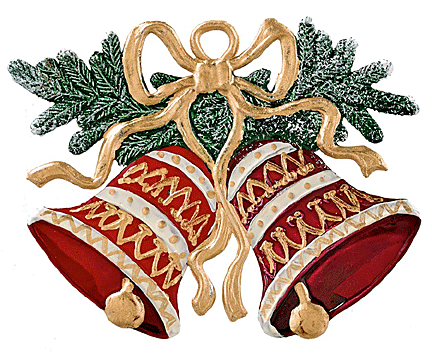 Silver
bells, jingle bells, sleigh bells, church bells—all help to bring cheer
and merriment to holiday celebrations today. But the tradition of
ringing bells at the onslaught of winter goes back centuries when people
rang bells to ward off evil spirits who they thought would bring bad
fortune and disease during the winter months.
Silver
bells, jingle bells, sleigh bells, church bells—all help to bring cheer
and merriment to holiday celebrations today. But the tradition of
ringing bells at the onslaught of winter goes back centuries when people
rang bells to ward off evil spirits who they thought would bring bad
fortune and disease during the winter months.
Bells, especially church bells, have traditionally been associated with
Christmas for a long time. In the Anglican and Catholic churches. The
church day starts at sunset, so any service after that is the first
service of the day. So a service on Christmas Eve after sunset is
traditionally the first service of Christmas day, and churches that have
bells often ring them to signal the start of this service.
In some churches in the United Kingdom, it’s traditional that the
largest bell in the church be rung four times in the hour before
midnight and then at midnight all the bells are rung in celebration.
It’s impossible to imagine Christmas without hearing or thinking of the
many different bells heard throughout the season.
The History of Bells
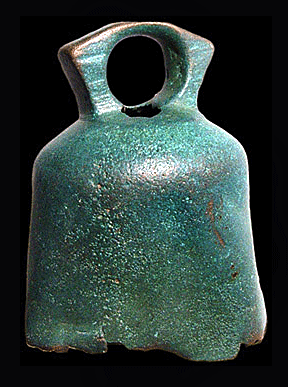 Shaped
like cups, the earliest bells needed to be struck to make a sound.
Perhaps it all began when someone hit a copper cup with a wooden stirrer
or spoon. Later, this evolved into purposely made bells with internal
clappers.
Shaped
like cups, the earliest bells needed to be struck to make a sound.
Perhaps it all began when someone hit a copper cup with a wooden stirrer
or spoon. Later, this evolved into purposely made bells with internal
clappers.
The Assyrians, Babylonians, Egyptians, and Sumerians soon discovered
that attaching small bells to the harnesses of camels, horses, and mules
could alert people walking along the roads of an approaching driver.
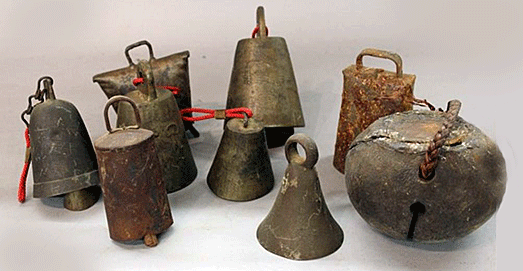
It wasn’t until the 4th or 5th century that large cast bells began to
appear in Europe. Bronze bells would be hung in church towers and rung
to call villagers to services. Traditionally, bells sounded on Christmas
Eve to announce the start of the holiday service. Churches also rung
bells to announce births, marriages, and funerals.
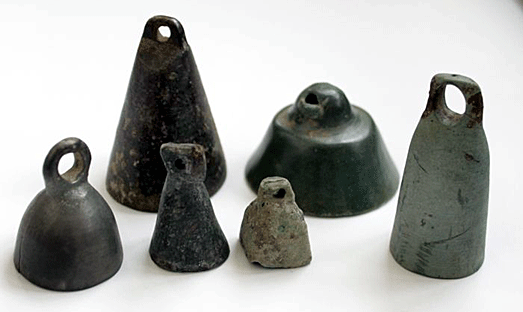
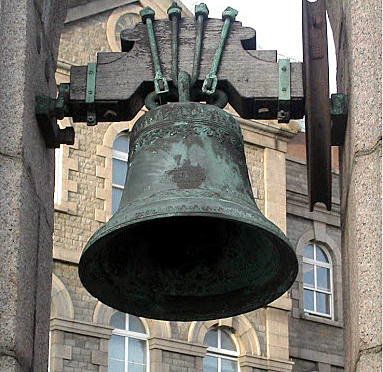 During
the Middle Ages, bells became a popular form of communication. Usually,
the largest building in the city was the church and within the church
was a bell. This bell would be ringing for a variety of reasons but each
reason centered around communication. Bells would be used to communicate
the time of day, the arrival of important persons, important
announcements, the beginning and end of various events, and they would
also be used to announce special celebrations.
During
the Middle Ages, bells became a popular form of communication. Usually,
the largest building in the city was the church and within the church
was a bell. This bell would be ringing for a variety of reasons but each
reason centered around communication. Bells would be used to communicate
the time of day, the arrival of important persons, important
announcements, the beginning and end of various events, and they would
also be used to announce special celebrations.
Like many of the traditions around Christmas, people first rang bells
during pagan winter festivals to protect the people of the city from
evil spirits. As Christianity gained influence the use of bells changed
from a pagan purpose to a Christian one. The infamous St. Patrick often
rang bells to signify the beginning and end of his lessons.
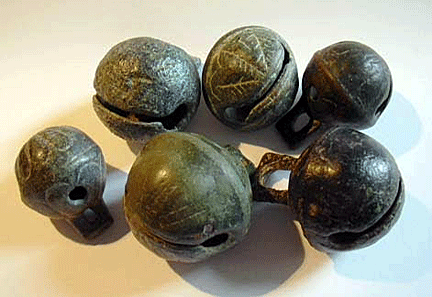 Another
smaller form of bell, called a “crotal bell,” or more commonly a “jingle
bell,” appeared in England in the 13th century. Craftsmen first made
these by bending a flower-shaped piece of sheet-metal into a ball
containing a solid metal sphere or rod that "jingled" when shook. Other
craftsmen made these bells from two small sheets of metal molded into
cup shapes which they soldered together.
Another
smaller form of bell, called a “crotal bell,” or more commonly a “jingle
bell,” appeared in England in the 13th century. Craftsmen first made
these by bending a flower-shaped piece of sheet-metal into a ball
containing a solid metal sphere or rod that "jingled" when shook. Other
craftsmen made these bells from two small sheets of metal molded into
cup shapes which they soldered together.
Soon, knights started attaching crotal bells to their horses. In the
16th and 17th century, gold- and silver-plated bells engraved with coats
of arms were presented to soldiers as awards. In the 18th century, wagon
drivers in England and Wales started putting jingle bells on horses
pulling their vehicles.
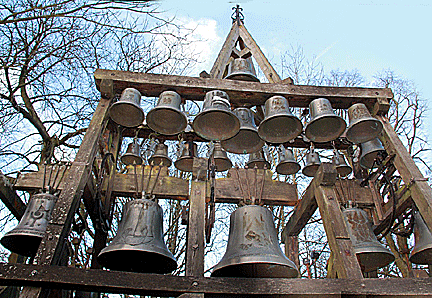 In
1510, the first set of carillon bells was introduced by a jester
performing outside a Flanders town hall. Foundries in the Low Countries
continued to develop the carillon bells until they emerged as a
full-fledged tuned musical instrument in 1644, the first of which was
placed in a Dutch wine tower. Churches quickly adopted carillons to use
for their Christmas celebrations.
In
1510, the first set of carillon bells was introduced by a jester
performing outside a Flanders town hall. Foundries in the Low Countries
continued to develop the carillon bells until they emerged as a
full-fledged tuned musical instrument in 1644, the first of which was
placed in a Dutch wine tower. Churches quickly adopted carillons to use
for their Christmas celebrations.
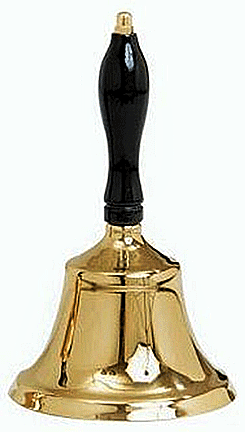 By
the 19th century, these horse bells were no longer just practical. In
England, they became associated with Christmas festivities including snowy
pleasure rides on decorated sleighs pulled by handsome horses wearing
polished bells. At this time, jingle bells became known as "sleigh
bells." Another big part of the Victorian Christmas season was caroling,
and it became trendy for carolers to carry small cup-shaped handbells
with them. Eventually, foundries developed tuned sets of handbells so
that carolers, bands, and church musicians could play recognizable songs
on the bells without singing.
By
the 19th century, these horse bells were no longer just practical. In
England, they became associated with Christmas festivities including snowy
pleasure rides on decorated sleighs pulled by handsome horses wearing
polished bells. At this time, jingle bells became known as "sleigh
bells." Another big part of the Victorian Christmas season was caroling,
and it became trendy for carolers to carry small cup-shaped handbells
with them. Eventually, foundries developed tuned sets of handbells so
that carolers, bands, and church musicians could play recognizable songs
on the bells without singing.
Around 1810, William Barton launched a company in East Hampton,
Connecticut, to produce sleigh bells and handbells in the United States.
He generously taught the trade to others so that East Hampton became
known as "Belltown" or "Jingletown." It was reported that East Hampton
produced about 14,000 bells in 1839, but by 1850, thanks to a new
stamping process, the town was churning out nearly 3 million sleigh
bells.
Sleigh bells were such iconic Christmas items by the 1850s that they
became central to seasonal poems and songs. In 1857, American songwriter
James Lord Pierpont wrote "One Horse Open Sleigh"―more
commonly known as "Jingle Bells"―which remains one of the most popular
Christmas songs in history.
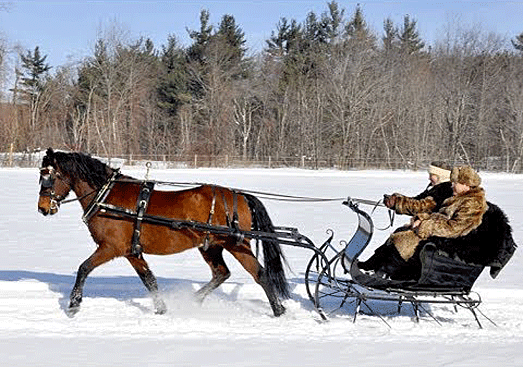
During the Civil War, American writer Henry Wadsworth Longfellow wrote
the poem "Christmas Bells" to express his dismay about the war
contrasting with carols of "peace on Earth, goodwill to men." His poem
was set to music for the 1872 carol, "I Heard the Bells on Christmas
Day."
Bell choirs first imported tuned handbells to the United States around
the turn of the 20th century. In 1914, Ukrainian composer Mykola
Leontovych and lyricist Peter J. Wilhousky wrote "Carol of the Bells."
Collecting Christmas Bells
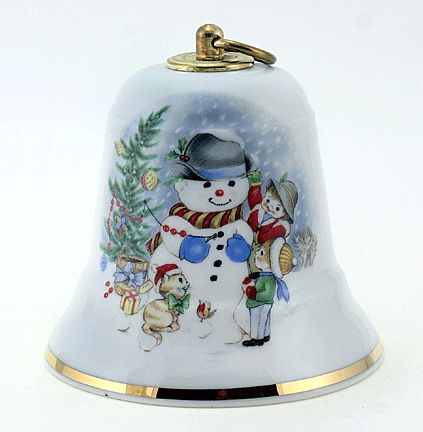 There
are so many variations and items containing Christmas bells that it’s
difficult to know where to start a collection. In any case, it’s
probably better to specialize in one category.
There
are so many variations and items containing Christmas bells that it’s
difficult to know where to start a collection. In any case, it’s
probably better to specialize in one category.
In 20th-century America, bells became an important part of Christmas
celebrations and décor. Manufacturers made ornamental bells to hang on
Christmas trees and bell-shaped Christmas lights.
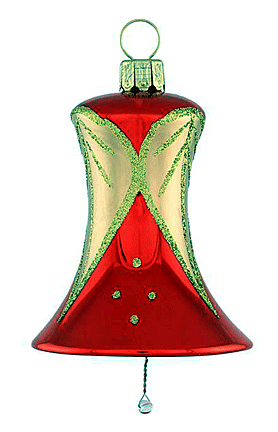 Porcelain
companies like Lladro, Napco, and Lefton produced ceramic figural bells
shaped like angels, carolers, or other Christmas symbols.
Porcelain
companies like Lladro, Napco, and Lefton produced ceramic figural bells
shaped like angels, carolers, or other Christmas symbols.
Other manufacturers produced a variety of bell-shaped tree ornaments.
Those made of blown glass were popular in the 1940s and 1950s. Many
makers of Christmas ornaments issue porcelain annual bells in December
of each year.
Bells have also been a popular motif for Christmas jewelry. Brooches and
pendants are particularly collectible.
< Back to Collecting Archives
Next Article >
